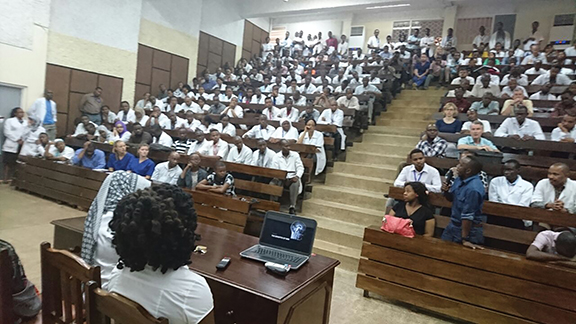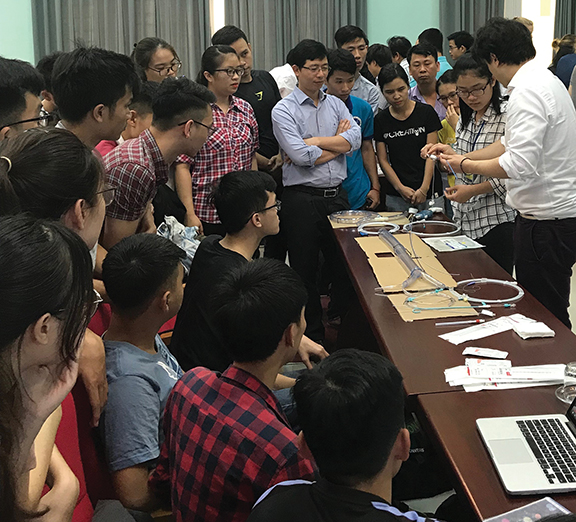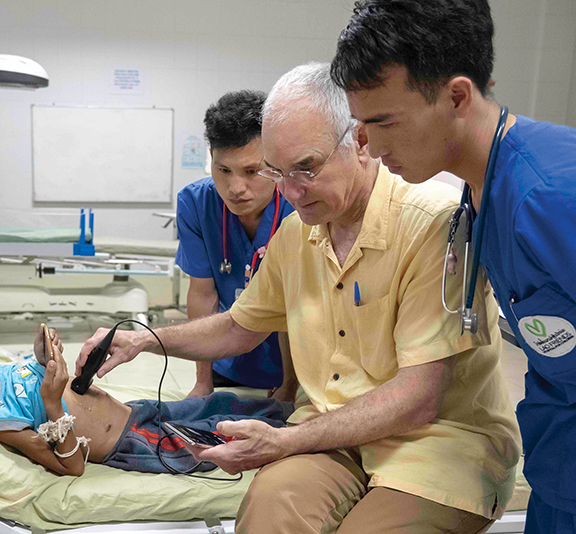Striving to Improve the World of Health Care
Images



During the past decade, the international healthcare community’s focus on the prevention and treatment of infectious diseases has steadily shifted to preventing and treating non-communicable diseases, such as cardiovascular disease, diabetes, cancer, and trauma, in the developing world.
This evolution is being accompanied by a growing demand for a cohesive and strategic approach to expanding access to basic and advanced medical imaging technologies in lower and middle-income countries (LMICs).
The World Health Organization (WHO) estimates that approximately half of the world’s population has no or inadequate access to radiology services, especially advanced imaging modalities like computed tomography (CT) and magnetic resonance imaging (MRI).1
This has key ramifications for the United Nations’ “2030 Agenda for Sustainable Development,” which sets 17 sustainable development goals (SDGs), eight of which relate to maternal health, child health, tuberculosis and human immunodeficiency virus, non-communicable diseases, road traffic accidents, reproductive health, universal health coverage, and healthcare personnel.
Medical imaging plays a major role in many aspects of all these targets; progress toward achieving the goals set for them can only be made with global access to basic modalities such as X-ray and ultrasound, and improved access to advanced modalities like CT and MRI.2
Yet multiple roadblocks have slowed the growth of radiology on a global scale. As a capital- and knowledge-intensive specialty, radiology’s role in global health has been limited by a lack of capital for hardware acquisition, of opportunities for radiologic education, and market dynamics that impact the availability of medical imaging professionals.3
Moreover, many LMICs face significant inequality in access to medical imaging services and, sometimes, injudicious use of existing resources. Appropriate data to inform future strategic planning, policy, standards, and guidelines is also scarce.2 Regional variability accentuates these problems and hinders adoption of uniform policies for individual countries and/or regions.
The good news is that there has been rapid progress in overcoming these obstacles in recent years, shaping today’s global radiology landscape and are creating blueprints for future outreach.
A number of high-profile medical imaging organizations have been integral to this progress. Among them:
The Radiological Society of North America (RSNA). The RSNA has been involved in international outreach for past 25 years, aiming to foster radiology education in resource-limited countries. The society is working to provide academic, logistical, and administrative support through the Committee on International Radiology Education with such initiatives as the International Visiting Professor program, the Derek Harwood-Nash International Fellowship, the Introduction to Research for International Young Academics program, and the Education Materials and Journal Award program. The RSNA also recently introduced a new initiative known as the Global Learning Center.4
American College of Radiology (ACR). Since 2004, the ACR has been committed to improving radiological care in the developing world by donating educational materials, providing volunteer travel grants, and hosting seminars and other programs. The Goldberg-Reeder Resident Travel Grant sends radiology residents to provide services in developing countries. The ACR’s Global Humanitarian Award recognizes individuals, organizations, and programs that improve access to radiological services in LMICs.5
American Society of Radiologic Technologists (ASRT). The ASRT’s global outreach programs give medical imaging technologists and radiation therapists the opportunity to participate in outreach to underserved communities around the world.
Rad-Aid International (RAD-AID). Founded in 2008, RAD-AID has grown to become a leading nonprofit, involving more than 14,000 volunteers from 140 countries, including physicians, medical students, technologists, nurses, medical physicists, administrators. and biomedical engineers. RAD-AID’s outreach efforts span 80 hospitals in over 35 countries.(Figure 1) A cornerstone of the group’s strategy is its Radiology Readiness Tool, which is endorsed by WHO and consists of a systematic data collection tool for assessing how to plan and implement advanced imaging technology to best match the medical needs and infrastructure/personnel resources of communities. This approach leads to the long-term sustainability and measurable outcomes RAD-AID programs.6
World Federation of Pediatric Imaging. This nonprofit provides an international platform for pediatric radiology organizations to address the challenges of training in and delivery of pediatric imaging services.7
Health for the World. This nonprofit focuses on promoting health care in resource-poor communities worldwide through free health education and technology-driven health solutions.8
Road2IR. Started in 2018, Road2IR provides a model for global outreach in interventional radiology, focusing in particular on developing self-sustaining IR training programs in East Africa.9
Imaging the World. This nonprofit focuses on international rural healthcare, emphasizing the growth of human and technical capacity to offer high-quality ultrasound services.10
Education is a key prerequisite building block in the creation of a much-needed workforce in radiology. Growth of global radiology workforce education is occurring on multiple fronts, including the development of:
• Programs for physician trainees, including radiology residencies and fellowships in LMICs (Figure 2);
• Ancillary radiology personnel, including the training of technologists, nurses, administrators, physicists, and biomedical engineers;
• Curricula for US-based trainees that have already led to the development of global health tracks and resident rotations at many institutions, some of which are implementing their own programs. Some universities are partnering with institutions in other countries. For example, Emory University working with Black Lion Hospital in Ethiopia. Others are partnering with organizations like RAD-AID for project development.
• Education for radiology professionals, many of whom are already active in global health efforts through non-academic and/or private arenas. The online RAD-AID Certificate of Proficiency in Global Health Radiology and Radiation Oncology trains medical imaging professionals to design and conduct their own international projects.
As a technologically driven specialty, radiology faces challenges to its growth in LMICs. However, recent innovations have made it easier to overcome these obstacles. Indeed, innovation is happening along two primary lines.
One is the development of low-cost alternatives to high-cost imaging services. The use of handheld ultrasound devices at the point of care is a case in point (Figure 4) In addition, cell phones are enabling providers in LMICs to transfer data in the health care sector.
A second line is leveraging picture archiving and communication systems and cloud-based data storage to help accommodate expanding storage and sharing requirements for optimal functioning of radiology departments. These technologies can facilitate implementation of teleradiology services to connect to the more remote areas. Geographic Information Systems such as advanced population data sets, topographical maps, and public health resources can be used to plan mobile services programs, which will help reduce health inequities present in LMICs. Strategic adoption of artificial intelligence (AI) by improving clinical radiology education, infrastructure implementation, and phased AI introduction will help bridge the global radiology gap.11
As the pace of global radiology outreach accelerates, so does the need for a platform to exchange ideas. In 2015, for example, the University of Massachusetts launched the online, open-access Journal of Global Radiology, a peer-reviewed publication that documents issues around global access to medical imaging services to low-income or resource-poor regions.12,13
And now, through a new, ongoing column in Applied Radiology, “Global Health Imaging,” we look forward to fostering a better understanding of how the radiology community can help improve the health of patients worldwide, particularly in low-resource areas.
Beginning next month, we will invite various medical imaging professionals to share the insights they have gained while developing and implementing their global health projects. Through this department, our goal is to help you, the readers of Applied Radiology, perhaps find your own path to contributing to the advancement of global health through our amazing specialty.
References
- Mollura DJ, Lungren MP. Radiology in global health: strategies, implementation, and applications. New York: Springer; 2014.
- Pitcher RD. “The role of radiology in global health.” Radiology in Global Health. Springer, Cham; 2019:157-174.
- Mollura DJ, et al. 2016 RAD-AID conference on international radiology for developing countries: gaps, growth, and United Nations sustainable development goals. J Am Coll. Radiol. 2017;14(6):841-847.
- Silva CF, et al. RSNA Committee on International Radiology Education: 25 Years of Global Education Outreach. RadioGraphics. 2020;40(7):1938-1952.
- https://www.acr.org/Member-Resources/Volunteer/international-outreach. Accessed Aug.24, 2021.
- https://rad-aid.org. Accessed Aug.24, 2021.
- https://www.wfpiweb.org. Accessed Aug.24, 2021.
- https://www.health4theworld.org. Accessed Aug.24, 2021.
- https://www.road2ir.org/. Accessed Aug.24, 2021.
- https://www.imagingtheworld.org. Accessed Aug.24, 2021.
- Mollura DJ, et al. Artificial intelligence in low-and middle-income countries: innovating global health radiology. Radiology. 2020;297(3):513-520.
- http://www.jglorad.org/. Accessed Aug.24, 2021.
- https://escholarship.umassmed.edu/jgr/. Accessed Aug.24, 2021.
Citation
P M,. Striving to Improve the World of Health Care. Appl Radiol. 2021;(5):22-25.
September 10, 2021